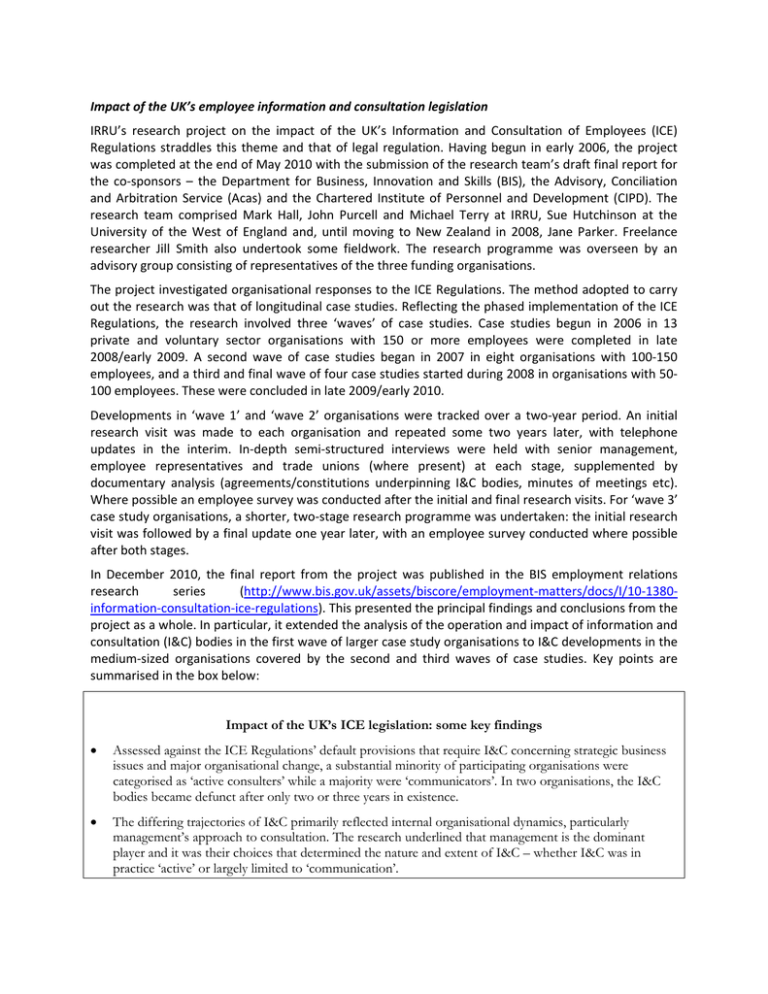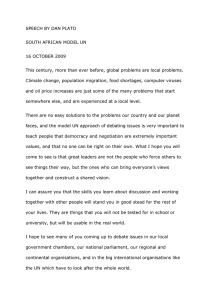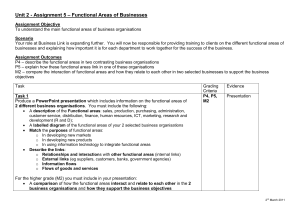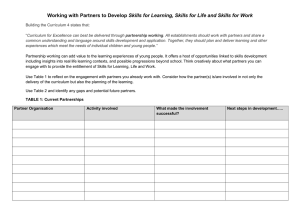Impact of the UK’s employee information and consultation legislation
advertisement

Impact of the UK’s employee information and consultation legislation IRRU’s research project on the impact of the UK’s Information and Consultation of Employees (ICE) Regulations straddles this theme and that of legal regulation. Having begun in early 2006, the project was completed at the end of May 2010 with the submission of the research team’s draft final report for the co‐sponsors – the Department for Business, Innovation and Skills (BIS), the Advisory, Conciliation and Arbitration Service (Acas) and the Chartered Institute of Personnel and Development (CIPD). The research team comprised Mark Hall, John Purcell and Michael Terry at IRRU, Sue Hutchinson at the University of the West of England and, until moving to New Zealand in 2008, Jane Parker. Freelance researcher Jill Smith also undertook some fieldwork. The research programme was overseen by an advisory group consisting of representatives of the three funding organisations. The project investigated organisational responses to the ICE Regulations. The method adopted to carry out the research was that of longitudinal case studies. Reflecting the phased implementation of the ICE Regulations, the research involved three ‘waves’ of case studies. Case studies begun in 2006 in 13 private and voluntary sector organisations with 150 or more employees were completed in late 2008/early 2009. A second wave of case studies began in 2007 in eight organisations with 100‐150 employees, and a third and final wave of four case studies started during 2008 in organisations with 50‐ 100 employees. These were concluded in late 2009/early 2010. Developments in ‘wave 1’ and ‘wave 2’ organisations were tracked over a two‐year period. An initial research visit was made to each organisation and repeated some two years later, with telephone updates in the interim. In‐depth semi‐structured interviews were held with senior management, employee representatives and trade unions (where present) at each stage, supplemented by documentary analysis (agreements/constitutions underpinning I&C bodies, minutes of meetings etc). Where possible an employee survey was conducted after the initial and final research visits. For ‘wave 3’ case study organisations, a shorter, two‐stage research programme was undertaken: the initial research visit was followed by a final update one year later, with an employee survey conducted where possible after both stages. In December 2010, the final report from the project was published in the BIS employment relations research series (http://www.bis.gov.uk/assets/biscore/employment‐matters/docs/I/10‐1380‐ information‐consultation‐ice‐regulations). This presented the principal findings and conclusions from the project as a whole. In particular, it extended the analysis of the operation and impact of information and consultation (I&C) bodies in the first wave of larger case study organisations to I&C developments in the medium‐sized organisations covered by the second and third waves of case studies. Key points are summarised in the box below: Impact of the UK’s ICE legislation: some key findings • Assessed against the ICE Regulations’ default provisions that require I&C concerning strategic business issues and major organisational change, a substantial minority of participating organisations were categorised as ‘active consulters’ while a majority were ‘communicators’. In two organisations, the I&C bodies became defunct after only two or three years in existence. • The differing trajectories of I&C primarily reflected internal organisational dynamics, particularly management’s approach to consultation. The research underlined that management is the dominant player and it was their choices that determined the nature and extent of I&C – whether I&C was in practice ‘active’ or largely limited to ‘communication’. • The degree of organisation among employee representatives was strongly influenced by management’s approach to I&C. ‘Active consultation’ required the development of representatives’ competence and coordination. In contrast, among the ‘communicators’, there was no imperative for a coordinated input from employee representatives and, as a result, little opportunity for representatives to develop the necessary cohesion to press for more effective consultation. • The extent of trade union engagement influenced the trajectory of I&C in a number of cases – both positively, e.g. where full-time officers played a key role at two of the ‘active consulters’, and negatively, where recognised unions sought to limit the remit of I&C bodies. Union concerns that the operation of I&C bodies could weaken their bargaining role and organisation proved largely unrealised. In some cases involvement in I&C bodies enabled unions to engage with a wider range of issues and afforded regular access to senior management. • The longitudinal design of the research captured the dynamic nature of I&C. Initial problems experienced by some organisations eventually categorised as ‘active consulters’ were overcome by a change of ownership/management or by employee representatives growing into their role. Conversely, early signs of effective consultation were not sustained in some of the eventual ‘communicators’. • Beyond being a catalyst for managerial moves to introduce I&C, and influencing the provisions and wording of some agreements or constitutions underpinning I&C bodies, the statutory framework proved largely peripheral. There was little evidence that the Regulations shaped managerial I&C practice, nor that they were used as a point of reference by employee representatives who, in any case, had no avenue for legal redress under ‘pre-existing agreements’ or I&C arrangements introduced unilaterally by management. In June and July 2010, Hall and Purcell presented a paper by the research team drawing on the overall findings from the project at two major conferences: an international conference on employee representation in Quebec, organised by the Canadian Industrial Relations Association (CIRA) and the Interuniversity Research Centre on Globalization and Work (CRIMT); and the European Congress of the International Industrial Relations Association held in Copenhagen. Hall was also an invited plenary speaker at the CIRA/CRIMT conference. His theme was ‘Britain’s reluctant accommodation of EU‐driven universal consultation rights’. In September, Hall and Purcell presented findings from the project at a seminar at King’s College London.





